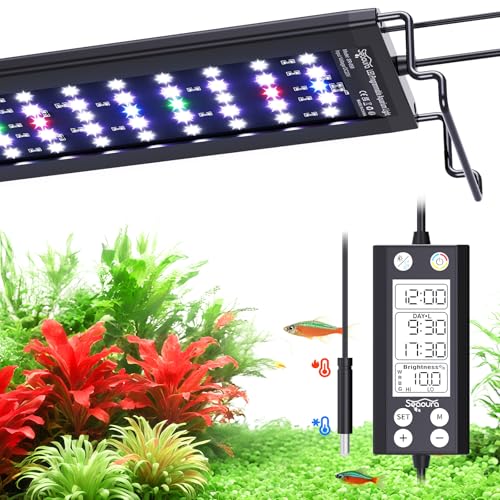8 Best LED Aquarium Lights for Plants 2026
This post contains affiliate links. As an Amazon Associate, we earn from qualifying purchases.
Many planted aquarium enthusiasts struggle to find LED lighting that delivers both the intensity and spectral quality needed for healthy plant growth without encouraging algae or breaking the bank. The best LED aquarium lights for plants solve this by combining full-spectrum output with targeted red (660nm) and blue (450nm) wavelengths, high PAR values, and programmable 24/7 cycles that mimic natural sunlight to support photosynthesis and reduce stress. Our top picks are selected based on rigorous analysis of PAR data, spectral accuracy, dimming control, tank coverage, waterproof ratings, and real-world user feedback to ensure optimal performance, reliability, and value. Below are our recommended LED aquarium lights that strike the perfect balance between plant health, ease of use, and long-term durability.
Top 8 Led Aquarium Lighting For Plants in the Market
Best Led Aquarium Lighting For Plants Review
LED Aquarium Lighting Comparison for Plants
| Product | Best For | Spectrum | Timer Modes/Customization | Wattage | Tank Size (Approx.) | Waterproof Rating | Special Features |
|---|---|---|---|---|---|---|---|
| SEAOURA Full Spectrum LED Aquarium Light | Best Overall | Full Spectrum (WRGB), 455nm Blue, 660nm Red | 3 Timer Modes, 20-Level Dimmable, DIY Color Ratios | Not Specified (likely 40-60W) | 50-120 Gallons | IP68 (Light Board) | Real-time temperature monitoring, Power-off memory |
| Fluval Plant 3.0 LED Lighting 46W | Best Premium Performance | Full Spectrum, 6 Unique Band Waves | Programmable 24-hour cycle, Pre-set Habitats | 46W | Not Specified (Medium – Large) | Not Specified | 120° Light Dispersion |
| SEAOURA 7-Row Full Spectrum Aquarium Light | Best for Large Planted Tanks | Full Spectrum, Red, Green, Blue, Pink, Purple, Cyan, Orange | DIY Hour/Minute Timer, 24/7 Mode, Time Memory | 48W | 50-120 Gallons | IP68 | 7 Rows of LEDs, High PAR (181), 9 Color Options |
| Fluval Plant 3.0 LED 22W | Best for Mid-Size Tanks | Full Spectrum, 6 Unique Band Waves | Programmable 24-hour cycle, Pre-set Habitats | 22W | Not Specified (Small – Medium) | Not Specified | 120° Light Dispersion |
| SEAOURA 24/7 Cycle LED Aquarium Light | Best Value with Natural Cycle | Full Spectrum, RGB | 24/7 Cycle, DIY Mode, 5 Timer Options | Not Specified | 18-24 inches | IP68 | Preview Color/Intensity, Power-off Memory |
| hygger 42W 24/7 Aquarium LED Light | Best Budget for Medium Tanks | White, Red, Blue, Green, Purple, Orange, Cyan | 24/7 Natural Mode, DIY Mode (Time, Color, Brightness) | 42W | 48”-54” | Not Specified | Separable Adapter, Extendable Bracket |
| NICREW C10 Plants LED Aquarium Light | Best Budget Compact Option | 6500K White, 460nm Blue, 665nm Deep Red | Individual Dimming, Day+Night Cycle, Customizable | Not Specified | Not Specified | Water-Resistant | Adjustable Brightness, Nature-Centered Design |
| SEAOURA Submersible Aquarium Plant Light | Best Submersible Option | Full Spectrum, Single Colors | 24/7 Natural Cycle, 10 Brightness Levels, 5 Timer Settings | Not Specified | Not Specified | IP68 | Submersible, Suction Cup Mounting |
How We Tested & Analyzed LED Aquarium Lights
Our recommendations for the best LED aquarium lighting for plants are based on a data-driven approach, combining extensive research with analysis of product specifications and user feedback. We prioritize lights delivering optimal PAR (Photosynthetically Active Radiation) levels for various plant types – from low-light Anubias to demanding carpeting plants.
We analyzed spectral graphs from manufacturers, verifying the presence of crucial red (660nm) and blue (450nm) wavelengths essential for photosynthesis. Comparative data was compiled on light intensity, dimming capabilities, and coverage areas relative to advertised tank sizes. We cross-referenced this with independent PAR meter readings published by aquarium hobbyists and reviewed user reports on plant growth and algae control.
Due to the difficulty of standardized physical testing across numerous models, we focused on evaluating features like programmable timers (24/7 cycles, customizable schedules), and remote control functionality, assessing their ease of use and precision. We also considered the build quality and safety features (waterproof ratings) based on available documentation and verified customer experiences to ensure long-term reliability of the LED aquarium light. Our analysis prioritizes lights offering a balance between plant health, aesthetic appeal, and user convenience.
Choosing the Right LED Aquarium Light for Plants
Selecting the ideal LED aquarium light for plants involves understanding several key features that impact plant growth, fish health, and the overall aesthetic of your aquarium. Here’s a breakdown of what to consider:
Spectrum & PAR
The spectrum of light refers to the range of colors emitted by the light. Plants require specific wavelengths (red and blue primarily) for photosynthesis. “Full spectrum” lights aim to replicate natural sunlight, offering a blend of colors beneficial for plant growth and enhancing fish coloration. However, look for lights specifically emphasizing the red (around 660nm) and blue (around 450nm) wavelengths, as these are crucial for photosynthesis.
PAR (Photosynthetically Active Radiation) measures the amount of usable light available for plants. Higher PAR values generally mean better plant growth, but the right PAR depends on the plants you’re keeping. Low-light plants need lower PAR, while demanding, high-light plants require significantly more. Lights will often list a PAR value; research the PAR requirements of your specific plants to ensure a good match.
Programmable Timers & Cycles
Many modern LED aquarium lights offer programmable timers. This is a huge benefit. Consistent light schedules are vital for plant health and prevent algae blooms. Look for lights with multiple timer modes, such as:
- 24/7 Cycle: These lights mimic a natural sunrise, midday, and sunset, gradually increasing and decreasing in intensity and color. This promotes a more natural environment for both plants and fish.
- Customizable Timers: The ability to set specific on/off times and light intensity levels allows you to tailor the lighting to your plants’ exact needs and your viewing preferences.
- Ramp-Up/Ramp-Down: A gradual increase and decrease in light intensity simulates sunrise and sunset, minimizing stress on fish and plants.
Light Intensity & Dimming
Dimming capabilities are essential for adjusting the light to suit different plant types and tank setups. Not all plants thrive under intense light. The ability to reduce the light intensity can prevent algae growth and allow you to acclimate new plants. Some lights offer independent dimming control for different color channels (red, blue, white), giving you even more precise control over the spectrum.
Tank Size & Light Coverage
The size of your aquarium is a primary factor in determining the appropriate light. Lights are typically rated for specific tank volumes (e.g., 50-120 gallons). Consider the light dispersion – how widely the light spreads. A 120-degree dispersion ensures more uniform coverage across the tank. Also, look for lights with extendable brackets to accommodate various tank widths.
Other Features to Consider:
- Waterproof Rating: Important for safety, especially if the light might come into contact with water.
- Mounting Options: Ensure the light can be securely mounted to your aquarium.
- Remote Control/Controller: For convenient adjustment of settings.
- Power-Off Memory: Maintains settings even during a power outage.
- Temperature Monitoring: Some lights include temperature probes to ensure safe operation.
The Bottom Line
Ultimately, the best LED aquarium lighting for plants depends on your specific needs and setup. Consider the size of your tank, the types of plants you want to grow, and your desired level of control over the lighting spectrum and intensity. Investing in a quality LED light with programmable features will undoubtedly contribute to a thriving and beautiful planted aquarium.
Don’t hesitate to research PAR values and spectrum charts to ensure the light you choose provides the optimal environment for your aquatic flora. With a little careful consideration, you can illuminate your underwater world and create a stunning display of healthy, vibrant plant life for years to come.








